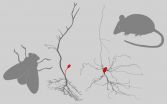INFORMATION:
Sundar worked with Saraswathi Bellur, assistant professor of communication, University of Connecticut, Qian Xu, assistant professor of communications, Elon University and Haiyan Jia, post-doctoral scholar in information sciences and technology, of Penn State, Jeeyun Oh, assistant professor of communications, Robert Morris University, all former Penn State doctoral students in mass communications.
Certain interactive tools click with web users
2015-04-21
(Press-News.org) Before web developers add the newest bells and the latest whistles to their website designs, a team of researchers suggests they zoom in on the tools that click with the right users and for the right tasks.
"When designers create sites, they have to make decisions on what tools and features they use and where they put them, which takes a lot of planning," said S. Shyam Sundar, Distinguished Professor of Communications and co-director of the Media Effects Research Laboratory. "You not only have to plan where the feature will be, you also have to design what will go underneath that layer, then create the content for it, so we wanted to know if these new, more sophisticated ways of interacting with a site are actually better than just clicking."
The researchers, who presented their findings today (April 21) at the Computer Human Interaction conference in Seoul, South Korea, suggest that interactive tools can not only affect how people use a website, but also how they feel about the site, what they think about its content and what information they retain after they use it.
In a series of studies, the researchers examined how people interacted with content using several web navigation tools, including clicking, sliding, zooming, hovering, dragging and flipping, along with combinations of those tools, according to Sundar. They also measured how much information they retained during the sessions as a way to test how absorbed the users were during the task.
Participants indicated that the slider, which allowed them to scroll along a timeline to view images and text about a historical event, was better at aiding memory than other tools, including a more recent navigational innovation, the 3-D carousel, which allows users to rotate images.
Sundar said that users spent more time on the carousel and interacted frequently with the tool, but that the number of interactions and length of time on the tool did not necessarily mean they found the carousel mentally engaging. Looks do not lead to better usability, he added.
"The 3-D carousel looks attractive, but in terms of encoding information, it was not effective," said Sundar.
This discrepancy between the high level of interaction and low level of satisfaction may also mean that a commonly used metric -- how long a person has remained on a site -- does not necessarily suggest a positive user experience.
"We used to think that the more time a user spent on a page or feature, or how 'sticky' it is, was a good thing and that it meant they were more interested in the page," said Sundar. "However, it could also mean they are confused and having trouble navigating."
Clicking, one of the web's early navigational tools, continues to be a popular choice for users, according to the researchers, who also found that the level of a user's web experience influenced the effect tools had on users' attitudes toward site content. For example, expert-level web users liked the content more and thought it was more credible when the site used simple clicking and mouse-over tools compared to less intuitive tools like the 3-D carousel and drag. The reverse is true for those who have limited expertise with technology.
"These techniques may be less natural to use, but they are seen as fancy by lay users," said Sundar. "They have a 'halo effect' on content."
Regardless of the differences across users, finding that these interactive tools can shape how users think and feel about media content is an important discovery, he added.
In the first study, the researchers recruited 128 college students and assigned them one of 20 different websites that were designed to test the interaction techniques. The content was the same on all the websites. The researchers then recruited 127 college students for a study that examined a combination of website tools. These participants were assigned one of six different website versions designed to test their reaction to those combinations.
ELSE PRESS RELEASES FROM THIS DATE:
New tabletop detector 'sees' single electrons
2015-04-21
CAMBRIDGE, Mass. -- MIT physicists have developed a new tabletop particle detector that is able to identify single electrons in a radioactive gas.
As the gas decays and gives off electrons, the detector uses a magnet to trap them in a magnetic bottle. A radio antenna then picks up very weak signals emitted by the electrons, which can be used to map the electrons' precise activity over several milliseconds.
The team worked with researchers at Pacific Northwest National Laboratory, the University of Washington, the University of California at Santa Barbara (UCSB), and ...
Global warming progressing at moderate rate, empirical data suggest
2015-04-21
DURHAM, N.C. - A new study based on 1,000 years of temperature records suggests global warming is not progressing as fast as it would under the most severe emissions scenarios outlined by the Intergovernmental Panel on Climate Change (IPCC).
"Based on our analysis, a middle-of-the-road warming scenario is more likely, at least for now," said Patrick T. Brown, a doctoral student in climatology at Duke University's Nicholas School of the Environment. "But this could change."
The Duke-led study shows that natural variability in surface temperatures -- caused by interactions ...
Cannabis consumers show greater susceptibility to false memories
2015-04-21
The study conducted at Sant Pau and Bellvitge hospitals, published in the American journal Molecular Psychiatry and conducted with the use of neuroimaging techniques, demonstrates for the first time that cannabis consumers have a less active hippocampus, a key structure related to the storage of memories.
Consumers of cannabis show distortions in their memories and can even come to imagine situations which differ from reality.
The study compared the memories of consumers to that of non-consumers to find differences in the retention of situations and experiences.
The ...
What happens when multiple sclerosis patients stop taking their medication?
2015-04-21
New research led by NYU Langone Medical Center examines what happens when a patient with multiple sclerosis (MS) who is clinically stable stops taking their medication.
The international, multi-site study found almost 40 percent of patients had some disease activity return when they stopped taking their meds.
The findings were presented at the American Academy of Neurology Annual Meeting held April 18-25, in Washington, D.C.
"Despite long periods of disease stability while taking medication, we found a large minority of patients who stopped experienced relapses or disability ...
Messenger RNA-associated protein drives multiple paths in T-cell development
2015-04-21
PHILADELPHIA - RNA is both the bridge between DNA and the production of proteins that carry out the functions of life and what guides which and how much protein gets made. As messenger RNA (mRNA) is transcribed from DNA to carry genetic information out of the nucleus, segments that don't code for actual proteins need to be removed from the RNA strand and the remaining pieces spliced together. Different pieces of the expressed gene (exons) are cut out, and these sections are joined together to form the final mRNA strand. Cells gain their ability to produce proteins with ...
Reflections on current state of situation awareness topic of JCEDM special issue
2015-04-21
Over the past 25 years, the construct of situation awareness (SA), or the perception and interpretation of what is happening around you, has been a catalyst for new advances in the human factors/ergonomics field, particularly in the areas of information display, automation, and training.
But recent advances also raise new questions, such as these: To what extent is SA about "awareness in the head" versus "awareness of where to look around you"? How is the process of maintaining SA affected by workload? Is it possible to have high-level SA about, for example, the progress ...
Trial shows benefit of 'BRCA-targeting' drug in prostate cancer
2015-04-21
Men with prostate cancer benefit from treatment with the pioneering drug olaparib - the first cancer drug to target inherited mutations - according to the results of a major trial presented today (Tuesday).
Olaparib was licensed in December for women with ovarian cancer and inherited BRCA mutations, but the new research suggests it could also benefit men with genomic faults within their tumours.
Researchers told the American Association of Cancer Research (AACR) conference in Philadelphia that up to 30 per cent of men with advanced prostate cancer had tumours with defects ...
Amazon rainforest losses impact on climate change, study shows
2015-04-21
Human activity has removed more than one-tenth of trees and plants from the Amazon rainforest since the 1960s, a study shows.
Widespread removal of trees has contributed to a rise in the amount of carbon dioxide in the atmosphere, increasing the potential impact of climate change, researchers say.
Deforestation of the Amazon accounted for 1.5 per cent of the increase in carbon dioxide levels seen since the mid-nineteenth century, the team says.
However, this increased the total amount of carbon found in the atmosphere only very slightly compared with fossil fuel ...
Fishing impacts on the Great Barrier Reef
2015-04-21
New research shows that fishing is having a significant impact on the make-up of fish populations of the Great Barrier Reef.
It's long been known that environmental impacts such as climate change and pollution are amongst the drivers of change on the Great Barrier Reef.
Now researchers from the ARC Centre of Excellence for Coral Reef Studies (Coral CoE) at James Cook University have found that removing predatory fish such as coral trout and snapper, through fishing, causes significant changes to the make-up of the reef's fish populations.
"A stable and healthy reef ...
Why some neurons 'outsource' their cell body
2015-04-21
Nerve cells come in very different shapes. Researchers at the Bernstein Center Berlin now reveal why, in insects, the cell body is usually located at the end of a separate extension. Using mathematical models, they show that this increases the strength of electrical signal transmission at no additional energetic cost.
Nerve cells follow a functional design: They receive input signals over more or less ramified cell branches (dendrites), which they forward to other nerve cells along an elongated, thin cell process (axon). The cell body contains the nucleus with genetic ...


